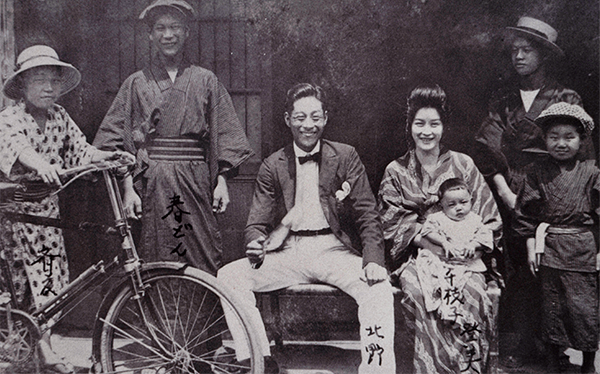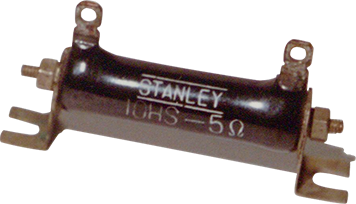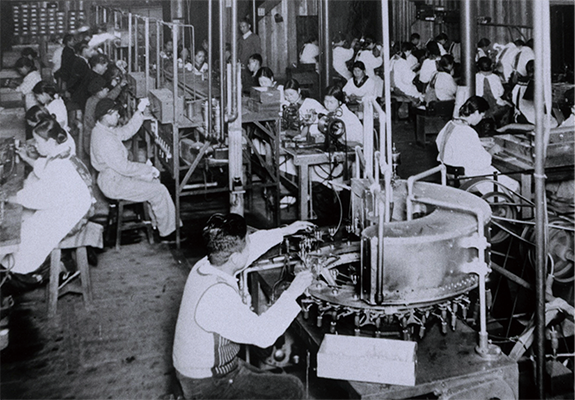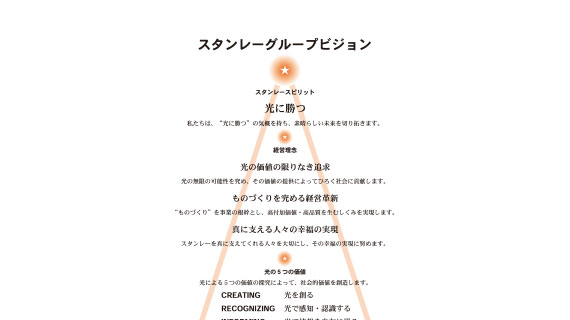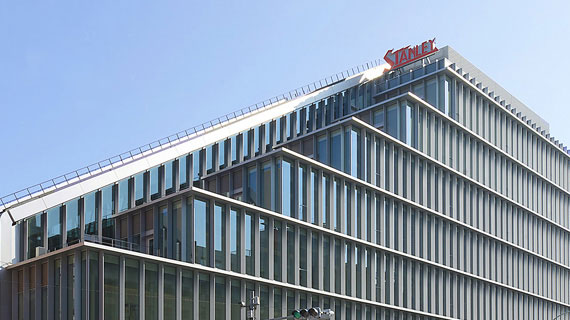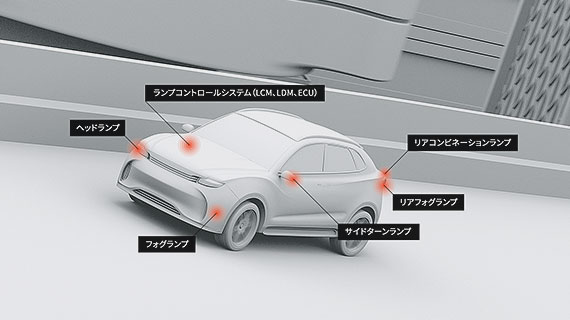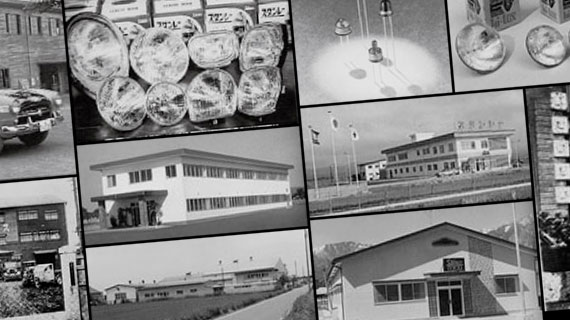- HOME/
- About Stanley/
- Stanley's 100th Anniversary Site
Stanley's 100th Anniversary Site

The Birth of Stanley Electric
In December 1920, Takaharu Kitano founded Kitano Shokai, a business that sold special light bulbs consisting mainly of automotive applications. Takaharu started the business from scratch: he did not have any capital funds, employees, nor customers. Even with these challenges, the company found a way to build a solid business foundation through exporting, but then lost everything in the wake of the Great Kanto Earthquake in 1923. Nevertheless, the company recovered, transformed into an independent manufacturer of light bulbs, and changed its name to Stanley Electric Co., Ltd. In addition, the company further expanded its businesses through development of resistors, selenium rectifiers, and other devices. This was a period when Stanley Electric laid out its basic foundation by overcoming many difficulties such as the earthquake and a war.。
Download the Chapter 1 PDFCHRONOLOGY
Takaharu Kitano founded Kitano Shokai and started out manufacturing and selling special light bulbs mainly for automotive applications
Founding Kitano Shokai from Zero
"I want to become the number one business in Japan quickly, even as a roasted sweet potato or an udon (noodles) vendor. But this is the beginning of the electricity era. I will engage in electrical products that require less capital."
Making up his mind, Takaharu Kitano started Kitano Shokai on December 29, 1920, which was the predecessor of Stanley Electric. He rented a shop that also functioned as a house in Shiba-ku, Tokyo City (currently, Shiba, Minato-ku, Tokyo), and then set up a private shop selling special light bulbs consisting mainly of automotive applications. The only things he had at the shop were worn tables and chairs and a little savings of 280 JPY. He had neither the capital, employees, nor customers. He had nothing and started exactly from scratch. This was when Takaharu was thirty years old.
Trademark established as "Stanley"
Recruited its first two employees
Received a mass order for automotive light bulbs from the J. H. Messabey Trading Company of America
The Great Kanto Earthquake completely destroyed the facilities of Kitano Shokai
Changed its trading name to Tokyo Kitano Shokai in commemoration of the company's relaunch
Recovery from the Great Earthquake, and the Change of the Company's Name
Two years and eight months after the start of the business, all of Takaharu's efforts came to nothing because of the Great Kanto Earthquake in September 1923. However, in December of the same year, he had a building constructed, which served as an office and a factory, and then changed the company's name to Tokyo Kitano Shokai to commemorate its relaunch. The company successfully recovered from the disaster. Despite the aftermath of the earthquake, the company greatly expanded its sales in both domestic and export markets and achieved the leading position in automotive light bulbs.
President Takaharu Kitano left for Europe and the U.S. for his first inspection tour
Launched permanent contact model special light bulbs
Launched the Crystal Star, a star-shaped decorative light
Completed the three-story office at 5-6, Tamura-cho, Shiba-ku, Tokyo City, Japan
Opened the Meguro Factory
Established Articles of Incorporation
Established Stanley Electric Co., Ltd. (Capital stock: 500,000 yen)
Takaharu Kitano appointed as President
Started to sell Baby Light, a small handy flashlight that utilized a miniature bulb
The Birth of Stanley Electric
At that time, the company was just a commercial business with no manufacturing department, but in May 1932, it built a factory in Meguro-ku, Tokyo City, where the current headquarters is located.
On May 5, 1933, the company changed its name to Stanley Electric Co., Ltd. to match its light bulb brand "Stanley," which was named after Henry Morton Stanley, a famous British explorer. The company then started to make a major effort to enter into the manufacturing industry.
While manufacturing light bulbs, Stanley Electric started to produce enamel resistors in 1935. These resistors turned out to be epoch-making in the company's expansion into the electric field. In 1940, the company also started manufacturing selenium rectifiers. This was how Stanley Electric began to emerge as a substantial electrical manufacturer.
However, in December 1944, the Pacific War broke out. The deadly bombing of Tokyo on the night of April 15, 1945, destroyed the Nakameguro headquarters, the factory, and the warehouse. It was the second disaster following the Great Kanto Earthquake.
Established the Osaka Branch (upgraded from a local office) as the first regional establishment
Started to manufacture enamel resistors
Launched an application of miniature bulbs as pistol lights, etc.
President Takaharu Kitano left for Europe and the U.S. for his second inspection tour
Launched the Compact Light, an application of miniature bulbs
Grand sale of Camera Light, an application of miniature bulbs, with free gifts
Relocated the Head Office and Sales Office to the factory area (Nakameguro)
Started to research and manufacture selenium rectifiers plates
Launched light bulbs for airplanes
Started to manufacture selenium rectifiers
The company name changed to Kitano Denki Kogyo Co., Ltd. in response to the prevailing situation
Increased capital stock to 1,000,000 JPY
Increased capital stock to 2,000,000 JPY
Opened the Todoroki Factory
The Head Office and the Meguro Factory were destroyed by the fire after the air raids
Kitano Denki Kogyo Co., Ltd. was dissolved due to the end of World War II
Takaharu Kitano founded Kitano Shokai and started out manufacturing and selling special light bulbs mainly for automotive applications
Founding Kitano Shokai from Zero
"I want to become the number one business in Japan quickly, even as a roasted sweet potato or an udon (noodles) vendor. But this is the beginning of the electricity era. I will engage in electrical products that require less capital."
Making up his mind, Takaharu Kitano started Kitano Shokai on December 29, 1920, which was the predecessor of Stanley Electric. He rented a shop that also functioned as a house in Shiba-ku, Tokyo City (currently, Shiba, Minato-ku, Tokyo), and then set up a private shop selling special light bulbs consisting mainly of automotive applications. The only things he had at the shop were worn tables and chairs and a little savings of 280 JPY. He had neither the capital, employees, nor customers. He had nothing and started exactly from scratch. This was when Takaharu was thirty years old.
Trademark established as "Stanley"
Recruited its first two employees
Received a mass order for automotive light bulbs from the J. H. Messabey Trading Company of America
The Great Kanto Earthquake completely destroyed the facilities of Kitano Shokai
Changed its trading name to Tokyo Kitano Shokai in commemoration of the company's relaunch
Recovery from the Great Earthquake, and the Change of the Company's Name
Two years and eight months after the start of the business, all of Takaharu's efforts came to nothing because of the Great Kanto Earthquake in September 1923. However, in December of the same year, he had a building constructed, which served as an office and a factory, and then changed the company's name to Tokyo Kitano Shokai to commemorate its relaunch. The company successfully recovered from the disaster. Despite the aftermath of the earthquake, the company greatly expanded its sales in both domestic and export markets and achieved the leading position in automotive light bulbs.
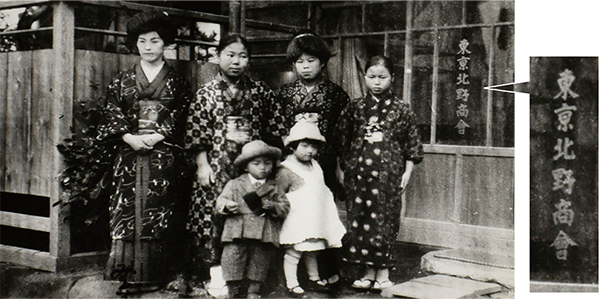
In front of Tokyo Kitano Shokai
President Takaharu Kitano left for Europe and the U.S. for his first inspection tour
Launched permanent contact model special light bulbs
Launched the Crystal Star, a star-shaped decorative light
Completed the three-story office at 5-6, Tamura-cho, Shiba-ku, Tokyo City, Japan
Opened the Meguro Factory
Established Articles of Incorporation
Established Stanley Electric Co., Ltd. (Capital stock: 500,000 yen)
The Birth of Stanley Electric
At that time, the company was just a commercial business with no manufacturing department, but in May 1932, it built a factory in Meguro-ku, Tokyo City, where the current headquarters is located.
On May 5, 1933, the company changed its name to Stanley Electric Co., Ltd. to match its light bulb brand "Stanley," which was named after Henry Morton Stanley, a famous British explorer. The company then started to make a major effort to enter into the manufacturing industry.
While manufacturing light bulbs, Stanley Electric started to produce enamel resistors in 1935. These resistors turned out to be epoch-making in the company's expansion into the electric field. In 1940, the company also started manufacturing selenium rectifiers. This was how Stanley Electric began to emerge as a substantial electrical manufacturer.
However, in December 1944, the Pacific War broke out. The deadly bombing of Tokyo on the night of April 15, 1945, destroyed the Nakameguro headquarters, the factory, and the warehouse. It was the second disaster following the Great Kanto Earthquake.
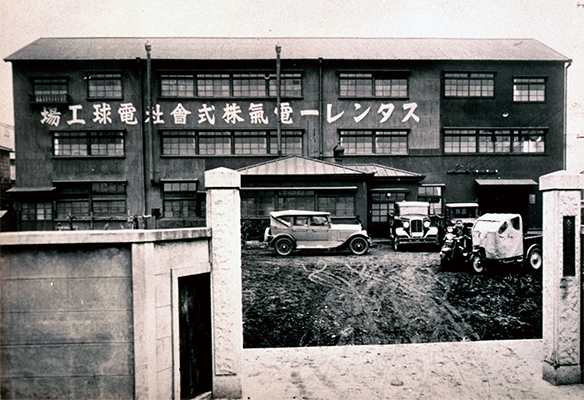
The Meguro Factory after being reorganized as a business corporation
Takaharu Kitano appointed as President
Started to sell Baby Light, a small handy flashlight that utilized a miniature bulb
Established the Osaka Branch (upgraded from a local office) as the first regional establishment
Started to manufacture enamel resistors
Launched an application of miniature bulbs as pistol lights, etc.
President Takaharu Kitano left for Europe and the U.S. for his second inspection tour
Launched the Compact Light, an application of miniature bulbs
Grand sale of Camera Light, an application of miniature bulbs, with free gifts
Relocated the Head Office and Sales Office to the factory area (Nakameguro)
Started to research and manufacture selenium rectifiers plates
Launched light bulbs for airplanes
Started to manufacture selenium rectifiers
The company name changed to Kitano Denki Kogyo Co., Ltd. in response to the prevailing situation
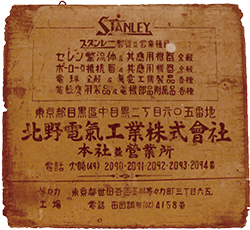
A wooden signboard with the name changed to Kitano Denki Kogyo in response to the prevailing situation
Increased capital stock to 1,000,000 JPY
Increased capital stock to 2,000,000 JPY
Opened the Todoroki Factory
The Head Office and the Meguro Factory were destroyed by the fire after the air raids
Kitano Denki Kogyo Co., Ltd. was dissolved due to the end of World War II
